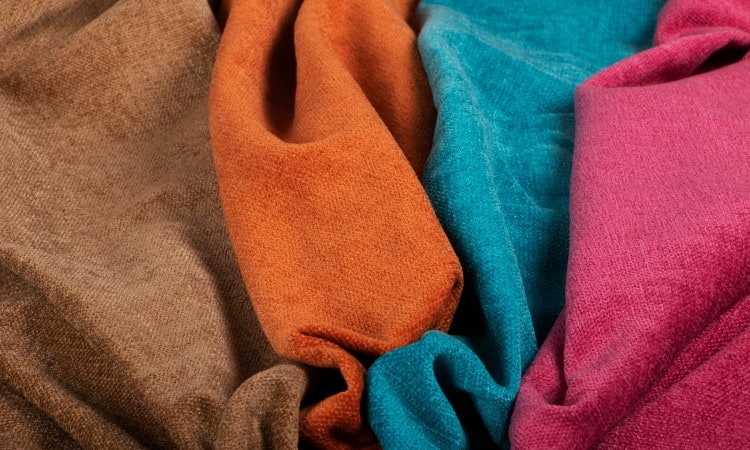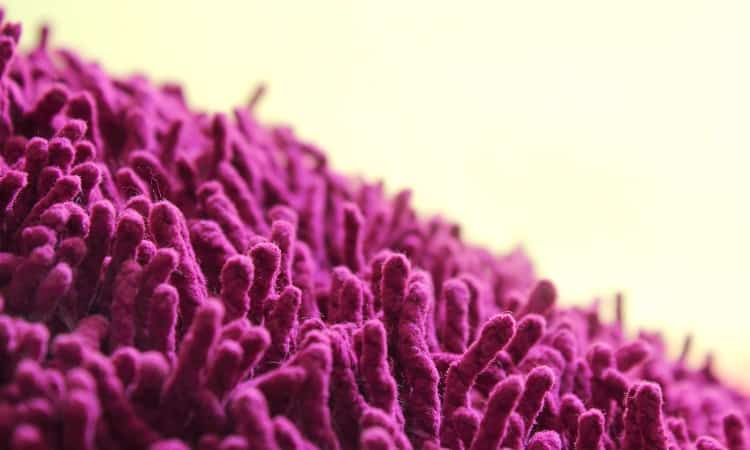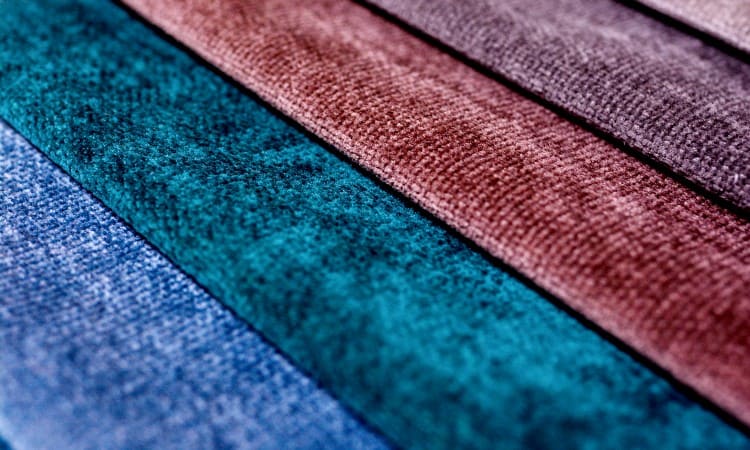There’s a new textile on my radar. It’s called chenille fabric. Although I’ve heard of chenille, I’m not sure if it’s a clothing material. I’m not even sure what it’s made from. Or how to use it. The question for today is, what is chenille fabric?
Chenille fabric is a soft material with a fuzzy texture. It can be made from cotton, silk, wool, rayon, and synthetic fibers and blends. The fabric is durable and can be used for upholstery, clothing, carpets, and rugs. Although it is a versatile material, it can be difficult to clean.
In this article, we’ll take a look at chenille fabric in detail, from its characteristics to its pros and cons. Read on to learn more about chenille and what you can use it for.

What Is Chenille Fabric?
Chenille is a soft fuzzy fabric with a tufted pile. The surface of the material has both thick and thin sections that create a ridged effect. It can be made from silk, wool, rayon, cotton, and synthetic blends. Considered an elegant fabric, chenille is popular for blankets and upholstery, but it can also be made into clothing.
As far as textiles are concerned, chenille is relatively new in the world of fabric. Although the yarns used to make the fabric can be traced back to 18th Century France, they didn’t appear in garments until the 1830s.
A Scotsman and mill owner called Andrew Buchanan is credited with being the first person to use chenille fabric for clothing. He used chenille yarns to create a textile suitable for use in shawls. These became a popular garment to protect against the variable weather conditions found in Scotland.
Originally, yarns used for the material were created by encasing one weft thread inside two warp threads. The warp threads were twisted together and the weft thread would have been threaded through them. This was known as the leno method. It was labor-intensive and slow-going to make the yarns in that way.
Some enterprising individuals decided to speed things up a bit. There are three names synonymous with furthering the popularity of chenille. First to upgrade the production process was a duo called James Templeton and his partner William Quiglay. They used their patented technique to make rugs.
The most famous name of all came later in the 1890s. A lady called Catherine Evans further enhanced the process of making chenille fabric. She had fallen in love with a super soft quilt she had seen when she was 12. By the age of 15, she’d done it! She’d not only recreated the quilting technique, but she’d also managed to revolutionize the way chenille was created.
Her efforts led to chenille becoming a popular choice for quilts and bedspreads. Although her original intention was to revive a quilting technique known as candle wicking, she helped put Georgia USA on the map for chenille mats, bathrobes, and carpets.
The textile’s name is a nod to its appearance and French origins. The fabric has a fuzzy surface reminiscent of the furry little caterpillars, it became known as chenille. Chenille is the French word for caterpillar.
How Is Chenille Fabric Made?

Although chenille fabric can be made from a range of fibers, the weaving method is the same. It has a unique production process that instantly identifies the fabric as chenille.
The actual method has evolved and improved over time. Partly due to modern techniques and, to some extent, the introduction of nylon.
Originally, the process used would have been the leno method. This is where two threads are twisted together and a third thread is woven between them. Thus creating an open weave held together by the twisted yarns. It’s the open, weaved fuzzy look that gave chenille its unique caterpillar trait.
The leno method was time-consuming and more than a little long-winded. It relied on manipulating the yarns by hand. One issue with the fabric was its propensity for balding. The pile in traditional chenille had an annoying habit of working loose over time, causing threadbare patches.
These days, production has been sped up a little. Although the basis of the material is still two threads encasing one, it’s done a little differently. It’s more of a sandwich approach.
Short lengths of yarn are placed between two core yarns and then twisted together. So the core yarns are the bread and the short lengths are the sandwich filling. More importantly, the twisting takes place after the three yarns are layered.
The resulting wrapped yarn forms little loops which are cut. This is how the caterpillar, or rather the fuzzy pile, is created. At this point, modern chenille differs even more from the traditional material. The yarn sandwich is treated with low-melt nylon to prevent bald or threadbare patches.
Adding nylon prevents the pile of chenille from coming undone. No more bare patches or balding! A further step to ensure chenille fabric keeps its tuftiness is the yarn is steamed to keep it in place.
Once that’s done, it’s safe to weave the steamy yarn sandwich into the fabric. Two different types of fabric are produced. One is used for upholstery and home décor. The other is used for bathrobes and clothing.
Chenille Fabric Characteristics

As well as being the name of the yarn used in the fabric, chenille is the type of weave used to make the material. Although items made from chenille look as though they are made from the same textile, there are two different chenille fabrics.
The first is home décor chenille which is used for drapes and upholstery. Then there is the chenille used for clothing and bathrobes.
Chenille fabric used in garments tends to be 100% cotton, although you can also get rayon and silk versions. Upholstery chenille has the benefit of nylon for extra durability. Each version may be designed for different tasks, but they have similar characteristics.
One of the more obvious characteristics of chenille fabric is its texture. Chenille is a fuzzy fabric covered in a short, tufted pile. It’s this pile that gives chenille its unmistakable similarity to a furry caterpillar.
That’s not all it does. The fuzzy pile is also responsible for the chenille’s ability to change color as you look at it from different angles.
Chenille’s surface is uneven with low and high points. When light hits the fabric, it creates a shimmer effect, picking out the color from the highs, leaving duller low sections. As you turn the fabric, these high and low points move, allowing the light to dance across the fabric, making it appear to change color.
The most appealing characteristic of chenille is its super softness and excellent drape. It’s an exceptionally comfortable material. Coupled with incredible heat-retaining qualities, chenille fabric makes an excellent cozy textile for warm winter clothing.
Although chenille is a versatile fabric with uses as diverse as clothing and carpets, it can be expensive. It’s a fabric linked to elegance and style packed with a huge dose of durability. But, those benefits come at a price. The production process for the fabric is intricate and can be tricky.
Another drawback is it can stretch out of shape, especially if you hang your chenille sweater out to dry when it’s wet. Most items made from chenille are dry clean only as it is incredibly susceptible to water damage. This makes it a difficult fabric to care for. Keeping it clean is even harder. The pile soaks up stains like a sponge making it a bad fabric choice if you have children or pets.
Whatever chenille you are dealing with, you’ll find it will always be soft, fuzzy, and luxurious. However, the level of softness and durability can change depending on the fiber contained in the chenille. As with most fabrics, the synthetic or natural content dictates the overall properties of the material.
What Is Chenille Fabric Used For?
 Chenille is a versatile and durable fabric that can be used for many uses. Its inherent softness makes it an ideal material for coverups and garments—especially blankets, sweaters, and shawls. There’s something comforting and cozy about snuggling into a chenille shawl. Even the thought of it can make you feel warm!
Chenille is a versatile and durable fabric that can be used for many uses. Its inherent softness makes it an ideal material for coverups and garments—especially blankets, sweaters, and shawls. There’s something comforting and cozy about snuggling into a chenille shawl. Even the thought of it can make you feel warm!
Then there is upholstery. Although chenille has a rough look, its super soft tufts make excellent sofa covers. The sparkle of the fabric gives a certain decadence to your furnishings. You can create an aura of style and sophistication without the price tag of velvet.
Carpets, rugs, and cushions are also good projects for chenille fabric. Its durability ensures you can achieve a hardwearing and beautiful floor covering. Whether you go for an area rug or a wall-to-wall carpet, your room will ooze elegance and finesse.
Chenille Fabric: Pros and Cons
As you probably noticed in the last section, chenille has its share of good and bad points. Both of which are down to the fabric’s unique weave.
Although the chenille weave gives the material a super-soft feel, there is a flip side to that benefit. It’s a fabric with an uneven texture, leading to some areas being bulky and others being very thin. This can make the fabric lose large chunks of its pile, causing bald patches.
Unsightly and more than a little annoying, balding isn’t chenille’s only problem. Although it’s one of the most durable fabrics, it can be incredibly tricky to keep it in tip-top condition.
From a propensity to fading to being hard to clean, chenille is a fabric that needs a careful hand. You also need to make sure you’re using it in the right place.
Hopefully, this next table will help you figure out if chenille fabric can be used for your next project. Let’s take a look at some of the main pros and cons of the textile so you can make an informed choice.
| Pros | Cons |
|---|---|
| Soft with a fuzzy texture | Stains easily and is hard to clean |
| Warm fabric ideal for winter clothing | Stretches out, especially when wet and can’t return to original shape |
| Thick and durable material ideal for upholstery, carpets, and blankets | Color fades easily, particularly in direct sunlight |
| Gives an elegant and sophisticated look to home décor | Not suitable for homes with pets. Their claws can get stuck in the pile |
| Drapes well | Expensive to purchase and maintain |
Chenille vs Velvet: What’s the Difference?
Chenille is often referred to as a poor man’s velvet due to the similarities between the two fabrics. This description is a little misleading, though. While both velvet and chenille are materials with a pile, the weave creating them is very different.
Velvet is a textile with a soft and smooth surface. It’s a warp-pile fabric and is woven as double cloth. This means two layers of material are woven together on top of each other. The pile is then cut, creating a level surface that catches the light uniformly. In materials like velvet, the pile is called the nap and indicates how the fabric should be sewn.
You need to make sure the nap is going the same way on all your cut pieces in all nap fabrics. With velvet, the nap runs down the material. Sewing a velvet garment with your pieces cut in different directions will stick out like a sore thumb.
You can see this effect yourself when you wear velvet items. Push your hand from top to bottom and the color will be light and even. Rub your hand against the nap, so you push the fibers upwards. It will be darker, with less shine.
In contrast, chenille fabric is a tufted pile material. Although it is a fabric with a nap, the direction of the pile isn’t as obvious as it is with velvet. This is down to the weave. Two core yarns are twisted together and a third yarn is threaded between them. It creates a single-layer fabric with a tufted surface.
With chenille fabric, light hits the fibers at different heights, So, instead of an all-over sheen, you get high points of sparkle intertwined with lower dull points, then low sparkles with high dull points. It’s more of an iridescent effect. When you turn the fabric, the light will hit different sections in different ways, making it look like it’s changing color.
The way light bounces across the surface of the two textiles isn’t the only difference. At first glance, velvet looks as smooth as it feels. You instantly know it’s going to be luxurious. On the other hand, Chenille looks rough or ropey from a distance yet feels soft to the touch.
To highlight some of the other key differences between chenille and velvet, we’ve put together a comparison table. This should help you analyze the two materials side by side, making choosing the best one for you and your project a lot simpler.
| Property | Chenille | Velvet |
|---|---|---|
| Absorbency | Very absorbent | Low absorbency |
| Appearance | Rough and ropey from a distance | Smooth and opulent |
| Cleaning | Hard to clean | Easy to clean |
| Fiber content | Cotton, silk, rayon, wool, synthetic fibers | Silk, rayon, polyester |
| Price | Can be expensive but it’s usually cheaper than velvet | Expensive |
| Texture | Soft and fuzzy | Soft and smooth |
| Weave | Two core yarns wrapped around one thread creating little loops on a single layer of fabric | Woven as a double cloth then separated to create a level surface of straight fibers |
How to Care For Chenille Fabric
Although it’s a durable textile, chenille fabric can be problematic to care for. Chenille is composed of a delicate tufty pile that is easy to damage. Because of this, many chenille items are dry-cleaned only.
Water is not a friend to chenille. The material can stretch out of shape when it’s wet. Unfortunately, chenille has no recovery properties, nor does it have any bounce. This means once it’s stretched, the damage is permanent.
Worse, chenille can also shrink. Many clothing and home décor manufacturers recommend you dry clean your items or take them to a professional cleaner to ensure their longevity.
It is possible to wash your chenille if you exercise extreme care. You’ll also need to pay particular attention to the care labels on your garments or upholstery. If in any doubt at all, play safe and seek professional assistance.
How you care for your chenille fabric is dependent on what kind of chenille you have. There are two types. You have washable and unwashable. Let’s take a look at both in detail.
Unwashable Chenille Fabric
Chenille fabric used for upholstery tends to be unwashable. Not necessarily because of the material, but because it’s hard to fit your sofa into your washing machine. When it comes to cleaning rugs, chairs, and even your carpets, you’ll need to spot treat them.
You will need:
- Clean lint-free cloth
- Clean Towels
Step 1
Simply dampen the area with a clean, lint-free cloth. Lint-free will ensure you don’t get fabric debris stuck in your chenille’s pile. Gently lift the stain or mark out of the chenille with the cloth. Don’t rub as this could damage the fibers. Move to a dry section of the cloth as it gets dirty.
Step 2
Blot the area with a clean towel to remove any excess moisture. Again, avoid rubbing as this will damage the chenille, allow to air dry.
Washable Chenille Fabric
It is possible to wash some chenille fabric. Clothing and small items like shawls, for instance, can be machine washed. However, due to the delicate nature of the chenille pile, hand washing is considered a lot safer.
You will need:
- Washing machine
- Bowl or sink
- Flat drying area
- Clean towel
Step 1
If you use a washing machine, place your item into a mesh bag. This will keep the garment in one place and less risk of snagging on the machine’s drum. Always wash chenille separately from other items. Set your machine on cold water setting with a low spin cycle.
For handwashing, fill a bowl or sink with lukewarm water and wash with your usual hand washing detergent. Rinse carefully and without wringing. You don’t want to twist or turn your garment to get the excess water out. Instead, roll it into a clean towel and gently push it down to expel the water into the towel.
Step 2
Regardless of whether your garment was machine or hand washed, you must dry it flat. Hanging it on a line or using a dryer will cause irreparable damage to the garment through stretching or shrinking.
Find a flat surface and lay a clean towel over it. Lay your garment on top of the towel, so it is completely flat. Leave to air dry. Keep checking on it periodically and reshape as needed. Don’t pull or twist the garment as you do this. Remember, a gentle touch is needed for chenille.
Conclusion
Chenille fabric is a super-soft, warm, and durable material suitable for several things. From carpets to garments, you’ll find chenille will add a touch of elegance to your wardrobe and your home. Although it’s tricky to care for, the decadent qualities of chenille make it a fabric worthy of the effort.
Do you have any chenille clothing? How do you care for it? Are you planning on using chenille fabric in your next project? Let me know in the comments.